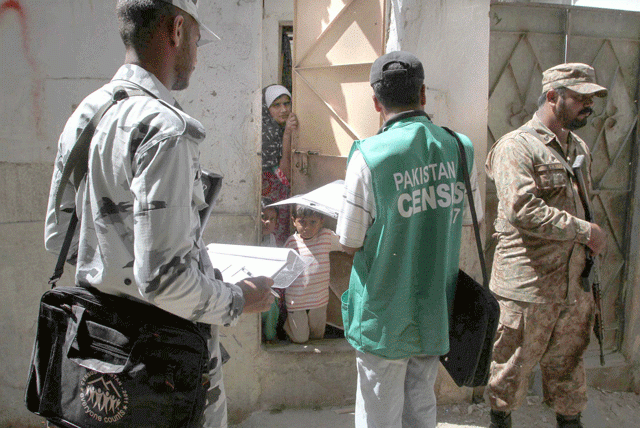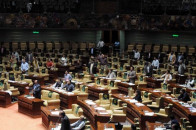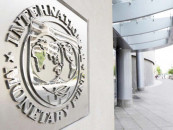Sindh’s six divisions see fractional change in population
Karachi Division hosts slightly over one-third of province’s total population

A census team in Karachi. PHOTO: EXPRESS / FILE
Any change in the population concentration patterns influences delimitation of seats for the National Assembly and the provincial assembly.
Out of the 16.05 million Karachi Division’s population, Karachi city’s population was 14.91 million or 92.9% of the division’s total inhabitants.
Karachi remains the most populated division of the province, followed by Hyderabad, Larkana, Sukkur, Shaheed Benazirabad and Mirpurkhas Division.
However, the percentage of people living in three divisions –Hyderabad, Larkana and Shaheed Benazirabad – slightly decreased during the past 19 years, showed the 6th Population and Housing Census results of the Sindh province.
The percentage of people living in Karachi Division increased 1.23% to 33.6% of the total population of the Sindh province. Similarly, Sukkur Division’s population inched up by 0.26% to 11.56%. Mirpur Khas Division’s population also slightly went up by 0.3% to 8.8% of the total provincial population.
The Pakistan Bureau of Statistics presented the provisional results of the 6th population census in the meeting of the Council of Common Interests on Friday. The final results are expected to be available by April next year.
6th census findings: 207 million and counting
According to the provisional results, Sindh was the most urbanised federating unit of Pakistan where the majority of people – 24.9 million or 52% – live in urban areas.
Sindh’s total population is estimated at 47.88 million, which is 17.5 million or 57.3% higher than the 1998 census results. The province had an average 2.41% annual growth rate, which is slightly above the national average.
Overall, Sindh’s share in total population of Pakistan remained unchanged at 23%.
Karachi Division
Karachi Division’s total population has been recorded at 16.051 million – higher by 6.195 million people or 62.85%, according to the provisional results.
Out of this, the Karachi city’s population was 14.91 million. Compared with the 1998 census results when 95.9% people used to live in urban areas, now 92.9% people are living in the metropolitan city.
The maximum concentration of Karachi Division’s population was in Karachi’s District West where 3.9 million lived, according to 2017 results. The district’s population grew by 87.4% or 1.825 million people during the past 19 years.
The Malir District witnessed the highest increase in Karachi Division, as the district’s population increased by 105.7% or 1.03 million to 2.1 million inhabitants.
The District Central’s population increased by 30.4% to 2.97 million. District East’s population increased by 97.5% or 1.435 million during the past 19 years to 2.9 million people.
Similarly, District South population was 1.791 million – higher by 21.2% or 313,000 persons.
Korangi District population was 2.45 million people, which was 896,000 people or 57.4% higher than the 1998 results.
Hyderabad Division
Hyderabad Division that comprises nine districts has a population of 10.592 million, up by 3.76 million or 55.1% during the past 19 years. The division hosts 22.12% of the Sindh province’s total population.
The maximum concentration of division’s population was in Hyderabad District where 2.2 million people live. Hyderabad district population grew by 47% or 704,000 people during the past 19 years.
The Badin District’s population grew to 1.8 million – higher by 63% or 698,000 individuals. Dadu district population stood at 1.55 million – up by 40% or 444,000 individuals.
Jamshoro District witnessed the highest increase among all districts in Sindh – 70.6% – and its population stood at 993,142 individuals.
Matiari district population increased to 769,349 with a 55.7% increase. Sujawal district population increased to 781,967 with 52% increase during the past 19 years. Tando Allahyar district population stood at 836,887 individuals and the district registered 69.6% increase.
Karachi up top, but not by much
Tando Mohammad Khan district population stood at 677,228 –registering 54.6% increase during the past 19 years. Thatta district population stood at 979,817 with 63.5% increase. The net addition in the district population was 380,000 people.
Larkana Division
The Larkana Division population – comprising five districts –increased to 6.192 million people. There was an addition of 1.98 million with an increase of 47%. The division hosts 12.93% of the province’s population – a reduction of 0.87% in past 19 years.
The maximum number of people lives in Larkana district where 1.524 million people reside. There was net addition of 522,000 people, which is 34.3% higher.
Jacobabad district population increased to 1.006 million, with a net addition of 279,000 people, which is 38.4% higher. Kashmor district’s population was 1.089 million and the district witnessed an addition of 412,000 people, which was 60.8% higher than 19 years ago.
Kambar Shahdad Kot district’s population was 1.34 million people, which was higher by 417,000 people or 45.1%. Shikarpur district’s population was 1.231 million and there was a net addition of 351,000 people in 19 years. The population was higher by 39.3%.
Sukkur Division
Sukkur Division – comprising three districts – has a population of 5.538 million, which was higher by 2.09 million or 60.6%. The division hosts 11.56% of the province’s population – up by 0.26% over 1998 results.
Ghotkhi District registered the highest increase of 70%, as its population increased to 1.646 million. There was a net addition of 677,000 people in 19 years.
The Khairpur District population was 2.4 million – the maximum in the division – and it was up by 55.3% or 856,000 individuals. The Sukkur District population was 1.487 million, which was higher by 59.8% or 556,000 individuals.
Mirpurkhas Division
The Mirpurkhas Division comprising three districts has 4.228 million people – higher by 1.69 million or 63%. The division has 8.8% of the province’s population.
Mirpurkhas district population was 1.5 million, which was higher by 499,000 or 49.6%. Tharparkar district has the maximum population of 1.649 million, which increased by 80% or 735,000 people during the past 19 years. The Umarkot district population was 1.07 million – up by 409,000 individuals or 61.6%.
Shaheed Benazirabad Division
Shaheed Benazirabad Division also comprises three districts and hosts 11.03% of the province’s population. It was half a percentage point less than 19 years ago.
The division’s population stood at 5.28 million that increased by 50.4% or 1.77 million people.
Sanghar district is host to 2.05 million people, which increased by 738,000 or 56%. Naushahro Feroze district’s population was 1.61 million, which was higher by 525,000 people or 48.2%. The Shaheed Benazirabad district population was 1.6 million. It increased by 46% or 510,000 people.



















COMMENTS
Comments are moderated and generally will be posted if they are on-topic and not abusive.
For more information, please see our Comments FAQ